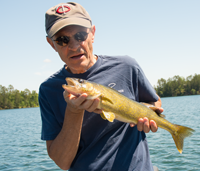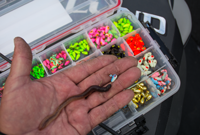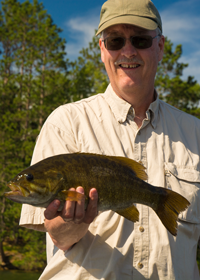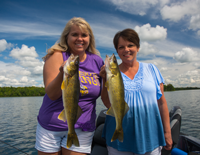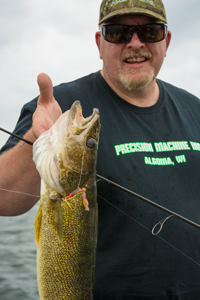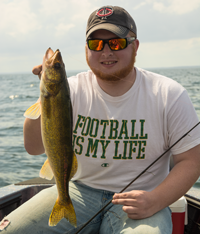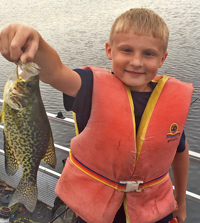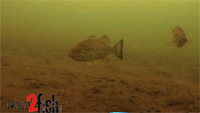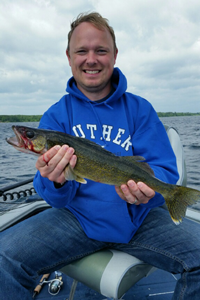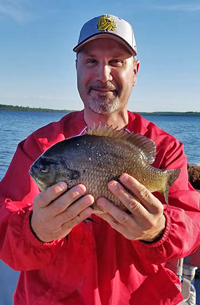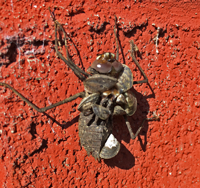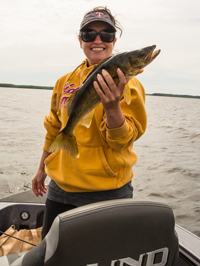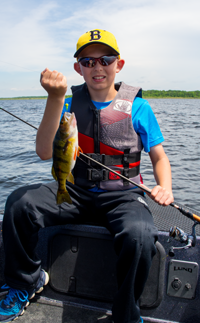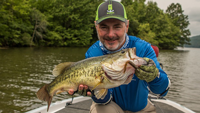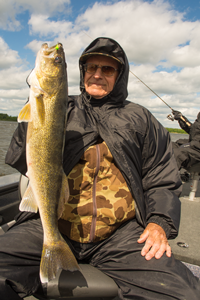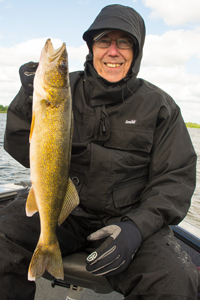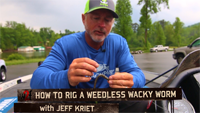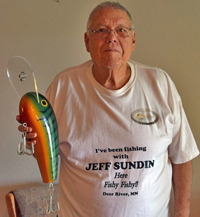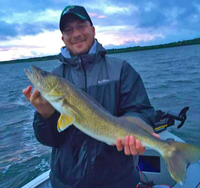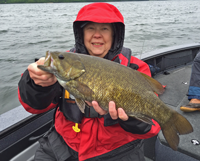Fishrapper Fishing Report Archives For June 2016
I also know that later, during the wee hours after dark, a lot of these fish will move into super shallow water and that will be the feeding run, the really big one.
What I still need to figure out is how to intercept them when they’re not in either place. Knowing how they get from one location to the other; that’s what I need to figure out. It’s like deer hunting, figuring out the travel route that leads between resting and feeding areas and then being there to head ‘em off at the pass. When I have it completely figured out, I’ll let you know first, and then I’ll quit fishing and become a farmer.
OH, by the way, the Walleyes we caught showed a strong preference for leeches and night crawlers. Large minnows, usually associated with catching large fish, came in a distant 3rd in the action department.
Like I said, the water depth ranged between 18 and 28 feet and the presentation was Lindy Rigs, ½ ounce No Snagg sinkers and 6 foot leaders tipped with crawlers or leeches. We never moved faster than .6 MPH and .4 MPH was my target as the ideal speed.
My crew, Randy and Bev Swenson are delightful, and they welcomed the “Hippie Chick” into their fishing trip too, that was also delightful. The fish were more cooperative than I expected and except for the gap in the action toward evening, it was a great day. I’m not sure that we’re supposed to get much luckier than that!
 Bowstring Lake, Geiger's Trails End Resort June 28, 2016;
Bowstring Lake, Geiger's Trails End Resort June 28, 2016;
"Bowstring has been one destination lake of choice for lots of anglers this season. The blend of Walleye, Perch and Pike has provided lots of action and for folks who sort them down, really nice bags of quality, eating size fish too.
Our guests, along with visitors from around the area enjoyed fabulous mixed bag Perch, Pike and Walleye fishing in the shallow, weed filled bays this spring.
There are still fish in the weeds, but some of the most popular areas have been heavily fished for a few weeks already and the action has slowed. If you’ll be creative and search areas where there aren’t a lot of boats, then you’ll enjoy better success.
The best presentations for weed fishing are Little Joe Spinners, #3 Gold Blades, tipped with fatheads and trolled at about 1.2 MPH. The spinners will produce a mixed bag of fish and the action will be very good. Jig and minnow presentations will work too, but be prepared to get snagged a little bit, the weed growth is green, lush and becoming very strong.
Walleye purists have been targeting fish on mid lake structure, in water depths of 16 to 24 feet. Lindy Rigs tipped with leeches and night crawlers are producing fish of mixed sizes. Some fish are bigger than others and although you will discover that there’s a very strong population of 11 to 13 inch fish in the lake right now, you will also find some fish of quality size too.
Crappie fishermen are reporting mixed results. The fish are scattered and moving primarily during the evening hours over deeper rock points and humps that have rocks on them. It’s not unusual to find fish along the weed edges too, but if there are lots of weed fish, they have not been reported.
Lake water levels are stable and surface temperatures are inching their way toward 70 degrees. Mother nature appears to be aligning conditions for a great 4th of July holiday!" - Bill & Erin Charlton, Trails End Reosrt .
 Lake Winnibigoshish, Joe Thompson, June 26, 2016 Four Seasons Resort;
Lake Winnibigoshish, Joe Thompson, June 26, 2016 Four Seasons Resort;
"We had a great week of fishing at the Four Seasons! Lake Winnie was in fine form for our guests this week. Believe it or not, the only species that was hard to find were the perch. I'm not talking about the 7-9" perch that are always biting, but the desirable ones in the 9" plus category.
Walleye fishing was outstanding. Most of the guests were using Lindy type rigs with leeches on the main lake structures. It was easy to find fish, but they wouldn't always bite. If you waited them out, there would be a feeding frenzy and the action was fast and furious. Then they would stop biting and you would have to wait them out for another couple of hours.
Those of you that know me know I would never be that patient! I would hit four spots instead of waiting them out and probably just hit another of the feeding times and catch them on another spot. There were numerous fish caught in the 18-23" protected slot, but there were an awful lot of keeper size fish, as well.
I had the pleasure of fishing with a family singing group from Nebraska on Thursday. They were novice fishermen and wanted to have enough fish for a fish fry that evening for......20 people! So my options were limited. Either go for perch or northerns. Since the only reliable perch spot was eight miles away with no guarantees, I opted for option two.
Armed with jigs and fathead minnows, we drifted down the breakline south of the River. I love it when a plan comes together. We brought in enough for the fish fry and they had a great time! I only had to tie on about a dozen jigs. We also caught a few nice perch and one walleye in the slot. Hopefully, they had a trip on Lake Winnie they will remember for a long time.
The reliable perch spot I found on Tuesday. We were targeting perch and found them tight to the largest cabbage weeds I could find. The only way we could catch them was to have our lines as vertical as we could. Fighting a 15 mph wind made this task a little tricky but we got the job done. The ratio of keepers (over nine inches) to throwbacks was 50% which is very good for perch fishing.
The fishing should stay this way until we have a major bug hatch. There have been no signs of that so far.
If you are looking for a place to bring the family for a week or just a few days, check our availability on the website, and give us a call." Joe Thompson, Four Seasons Resort 218-665-2231
 Cass Lake, Horseshoe Resort Fishing Report June 24, 2016
Cass Lake, Horseshoe Resort Fishing Report June 24, 2016
"Low light is the name of the game on Cass Lake right now. It really won’t make a difference how you accomplish it;" says veteran guide Chad Benson.
“Whether you fish early morning, late evening or during overcast weather, take advantage of good opportunities when they arise.”
Cass Lake’s water is super clear this season and that’s the reason that Benson is so adamant about targeting Walleye during high percentage periods. Gin clear water and Walleyes don’t mix well and when the sky is bright, Walleye disappear from their traditional haunts.
It’s not that they aren’t catchable, they are, but unless we target them on their terms, it’s going to be frustrating.
Increased water clarity is not unique to our lake this year, cool weather discourages plankton growth and that’s affected many of the lakes in our area. When these waters have a significant increase in Algae blooms, then more fish will return to structure during the daytime.
When it’s clear and sunny, daytime fishing is better suited for anglers who target Panfish and Bass. Heavy weed cover is holding Bass and Panfish and living in the shadows makes them easier to catch at mid-day.
When the sun hits the tree tops, Walleyes begin to feed and after dark, they are moving up onto shallow flats. Trolling shallow diving crankbaits will produce consistent catches at night, traditional presentations like Lindy Rigging remain effective at twilight.
"On overcast days, I can do okay says Benson,
any grey, drizzly day seems to make Walleyes return to places where I am used to finding them. Strong winds are okay too, the fish react by feeding, as long as it's not so rough that you can't get to your favorite spots."
We'll keep you posted about changing conditions on the lake, but if you have questions, give us a call.
Clark Heitmann - Horseshoe Resort on Cass Lake.
Some nice sized Pike have been hitting large cranks off weedy points in the early to late morning hours.
For once, the weather forecast for this weekend appears promising. There will be lots of opportunities to catch a nice mess of fish. Be sure to drop by the store and see what’s new and have a Great weekend everyone!!"
Frontier Sports features a complete and fully stocked Sporting Goods department and Bait Shop, Gas, Grocery, Deli and Gift Shop. Frontier Sports is an authorized LIVE TARGET and SAVAGE GEAR dealer. Frontier Sports 218-832-3901 or Email .
NEW!! Fish ED Internet Season; "Shallow Water, Pre-Spawn Bluegill" June 22, 2016"When the frantic action of the bluegills early-season feeding frenzy fades, most panfish fans focus their efforts on predictable spawning areas. But as Fish ED's Jon Thelen shows us, setting your sights on staging areas will help you get a jump on the action before bluegill hit the beds." View Fish ED >> Shallow Water, Pre-Spawn Bluegill |
 Jeff Sundin Ball Club Lake, Gus' Place Resort June 22, 2016
Jeff Sundin Ball Club Lake, Gus' Place Resort June 22, 2016
"When I stopped in to pay my launch fee at Gus' Place Resort on Tuesday, Gus said as long as you're here, you might as well write my fishing report for me; okay, so I am.
We were looking for a place to dodge at least some of the wind that was predicted to blow. My crew and I were hoping that Ball Club Lake would be manageable, but still serve up enough of “something” to satisfy our hunger for a shore lunch. Walleye are nice, but so are Crappie, Perch or Pike and Ball Club is capable of providing good action for any or all of them; we didn’t care all that much.
Our first stop was at “The Crappie Hole” and I thought we were off to a great start when Bill pulled in a 12 incher within minutes. But today, the Cabbage weeds that held Crappies a week ago were quiet. Either my timing was off, or the fish have dispersed, transitioning into their summertime pattern of feeding during the early morning and late evening.
For our next trick, Joe Stevens, AKA Stevens Magic, agreed with my suggestion to check out the “Walleye Hole”. This time our timing was better, although still not perfect; Walleyes were easy to find, but they tried to give us the illusion that they wouldn’t bite. Shear stubbornness allowed us to pick up a half dozen nice eaters, and that was more than enough to accomplish our shore lunch.
The fish that we did catch were located in 12 to 14 feet of water, adjacent to the weed edges. They struck Leeches presented on Lindy Rigs, with 3/8 ounce sinkers, six foot leaders and small hooks. I was able to keep my drift speed down to about .8 MPH, but I think if we’d slowed down more, we might have picked up a few extra fish.
There were enough Walleyes along the weed breaks to make believe that we could have caught more. Like the Crappies though, I think that they were a little shy during the mid-day, under the bright sky. If I was on vacation, staying at Gus’, I’d get up early and work those weeds while the sun was low in the sky and I’ll bet the fishing would be very good.
Our backup plan, Northern Pike, never made it onto the radar screen, so I’m not sure where the majority of them are located right now. The surface water was only 59 degrees on the lakes windswept north side and that tells me that most of the better Pike are liable to still be holding in shallow weds vs the deeper breaklines.
When it comes to lending a helping hand to guests, Gus is without doubt, one of the most generous with fishing information.
For today, anything is fair game. We might even be happy running a repeat of last years “Google Eye, Goggle Eye, Red Eye, Brown Eye” fishing tip. Whatever we do, you will be the first to know!
 Fishing Report Jeff Sundin, June 21, 2016 Solving the Solvable ...
Fishing Report Jeff Sundin, June 21, 2016 Solving the Solvable ...
Isn’t always pretty, but when fishing conditions get tough, you can put your head down, keep plodding along and with luck; gather enough for a respectable fish fry.
That’s how my day went on Monday when gusty west winds pinned us into the so-called “calm side” of Lake Winnie. By staying on deep water structure, close to the shoreline, we found and caught enough fish to call it a fishing trip. Admittedly, there was a certain lack of glamour, a shortage of pizazz if you will, but despite the turbulence, I was a lot happier than I would have been if the seas were calm and the skies were blue.
Luckily, my crew, Corey and Joel Schmidt have been around the block a few times. They recognized the challenge, joined me in the search and wore smiling faces the whole time. That sense of understanding is what keeps guys like me going, problem solvers appreciate knowing that they have room to work and that’s what they gave me, cheerfully.
This means that they’ve each earned an A+ score and received extra bonus credits on their first semester finals at the U of SSU! ![]()
I can’t say that I’m gonna make a bee-line back to the spots where we fished yesterday, but if you’re planning on fishing Winnie soon, then you may find enough fish to satisfy you on the west sides “Main Bars”.
We found small schools of Walleye located on the upper edges of both Sugar Bar and the River Bar. Key depths were 14 to 17 feet of water found along the upper edges of the drop offs and even on top of the large flats adjacent to them.
A ¼ ounce Lindy Jig tipped with a minnow caught a few of the fish, the others were caught Lindy Rigging with ½ ounce No Snagg sinkers, 6 foot leaders and night crawlers. I think that the jigs bagged most of the “eaters” and the night crawlers yielded more slot fish. The jig/minnow combos are always better at attracting pike and perch too, so if I was doing it again today, I’d stick with the jig and minnow all day long.
Surface temperatures held steady at 64.5 degrees all day long and the water clarity has increased noticeably since last week. Even in the whitecaps, we could easily see the bottom in 6 to 8 feet of water; that would really worry me on any calm day.
By this time tomorrow, there will be a more extensive report about Winnie, so if your weekend plans include a trip up, then hold on tight for another day. If you’re headed out there today, keep in mind that there is a decent weedline bite going, if you can get to it.
Spinners tipped with ½ night crawlers and fished over the weed tops in 12 to 14 feet of water worked well over the weekend, they will again as soon as the lakes settles back down after yesterday’s tantrum. So if we can manage today's wind, that's what I'll do, otherwise, plan b is anybody's guess.
Wired2Fish What Bass Look Like on Down and Side Imaging: Jason Sealock gives a great tutorial on what schooling bass DO and do NOT look like."Electronics arm anglers with the ability to find fish holding cover, structure and even schools of visible fish before wetting a line, but you're not finding anything unless you've learned to correctly interpret what's on the ... Learn More >> What Bass Look Like on Down and Side Imaging |
|
|
|
 Walleye Gardening, Post Storm Fishing - Jeff Sundin Fishing Report, June 14, 2016
Walleye Gardening, Post Storm Fishing - Jeff Sundin Fishing Report, June 14, 2016
Yesterday I ended my report with these words; “I’m not a gloom and doom guy, but I do know what I know, even when I don’t like it. As the storms move out of the area today and sunshine settles over calmer seas, my guess is that the fish that fed heavily yesterday are gonna feel like taking a nap today.”
Well, the report about Monday’s fishing trip could go either way, one way would be all about struggling to catch tough, post thunderstorm Walleyes under sunny skies, on mid-lake structure. Or the other way could be all about catching a nice mixed bag of Perch, Walleye and Pike in dense, shallow weed cover.
After a special consultation with the chancellor at the U of SSU, I’ve decided to meet in the middle and talk about the seemingly odd conflict between the two.
One would think it logical that fish holding in deep water would be less affected by and therefore more willing to strike after a major storm system. One would also think that fish holding in the weeds at 5 or 6 feet of water would have been scared away, or at least not willing to strike for a while after the storm.
On Monday, the fish reacted completely backwards to these assumptions. Fish holding in shallow water weeds were much easier to catch than were their deep water cousins and they were also larger in size. I will admit that the action was not as good as it had been before the storms, but at least the fish were catchable.
That was a really nice surprise and I’m sure that my customer and friend of 25 years, Jim Gandy would say “A Blessing”.
I don’t really have an explanation that’s based on hard facts, but as usual, I have a theory. I think that the fish located on deep water structure didn’t have any incentive to feed. The more bars I checked, the more fish my Humminbird revealed; but there wasn’t any bait, the bottom was clean and the fish were sitting still.
Add to that, almost everybody on the lake was in hot pursuit of these deep water fish. There were crowds on many spots, and most every one of the better spots had at least a boat or two fishing over them. The weeds on the other hand were only lightly pressured. In fact, we fished for several hours without ever encountering another angler.
The trick, if there was one, was to work in the thickest weeds we could find. That’s where the fish had enough shade to be comfortable under the sunny afternoon sky. Patches of Cabbage were the best, but we did catch some fish in Coontail patches and also along the outer edges of Eelgrass too.
Most of the fish we caught were Perch and small Pike, but there were enough Walleyes to keep it interesting. There were a few unfortunate losses that brought our total down, but we still managed to bag a half dozen keepers and released another dozen or more little ones.
We used 1/8 ounce Lindy Jigs tipped with small Golden Shiners. We made short casts, just far enough to get our lures away from the boat, but not far enough to lose sight of our bait. We hopped the jigs up and down, not side to side because in the dense weeds, vertical presentations are much less prone to snagging the garden plants.
Here’s the most important trick that I will ever tell you about fishing in the weeds, so hit the record button.
If you feel your jig touch a weed, DO NOT PULL on it! Instead, let your line go slack and allow the jig to fall even further into the weed patch.
Think about it, there is a lot less surface area at the base of the plants than there is near their bushy tops. If you were to feel a weed, and tug on it, you could become instantly snagged, you could become frustrated and begin pulling even harder, and then your lure would get snagged even more.
What’s worse is that after all the ripping and tearing, the fish never even see your presentation, they can’t strike what they don’t know is there, so you could catch nothing and you might go away upset, swearing to never fish in the cabbage patch again.
That would stink because if you took my advice and allowed your bait to fall under the bushy tops and into the clear spaces beneath the plants, then the fish would have an opportunity to see and strike your lure. Then you would catch them and become happy, you might even master this technique and become a life-long fish gardener.
Master this technique and you will almost always be able to scrounge up a meal, I Promise! ![]()
For me, a series of lucky guesses led us to 3 or 4 consecutive mid-lake bars that all had a few fish on them. I had a crew of 3, so for simplicity, I set aside the advice about rigging with leeches, instead we started with jigs and minnows. Luckily, the jig/minnow combo was equally effective and for a time, we were able to boat Walleyes of all shapes and sizes.
When the storms finally passed, strong winds complicated the fishing for a while. The fish were still active, but it was easy to see why the crew had trouble knowing that. In the heavy seas, it was all but impossible to feel a strike and keeping the lines organized was problematic too. By mid-afternoon, it was beginning to look like another day where the morning action was gonna have to hold us for the entire day.
That’s when the good news, bad news scenario unfolded. Another line of storms was rumbling toward us and these storms stalled the wind, just like what happened in the morning. As soon as we had control of our presentation again, all 4 of us began catching fish, the bite was better now than it was all day long and that allowed us to stage a nice, late inning rally before the storms arrived and cut our day short.
I’m not a gloom and doom guy, but I do know what I know, even when I don’t like it. As the storms move out of the area today and sunshine settles over calmer seas, my guess is that the fish that fed heavily yesterday are gonna feel like taking a nap today. If the Walleyes follow past patterns, then that is the most likely scenario.
We’ll be doing our best out there though and we won’t be giving up easily, you just never know, we might find a way to beat the odds, especially if the weather remains un-settled, that could help a lot.
By the way, when I wrote about Sand Lake yesterday, I ran short of time before I could mention a curious phenomenon that Mark and Amy Hinzmann shared with me. Look close at the photo on the right and you’ll see what I believe is a Dragonfly Nymph that creeped out of Sand Lake and up the wall of the Hinzman’s cabin.
Look even closer and you’ll see that riding on the Nymph's back are some Zebra Mussels. That makes me wonder, if the Zeebs can get out of the lake without human intervention, then how in the heck are we supposed to prevent them for getting into the next lake and the next one and so on?
If you ask me, it’s time to double down and put all of the money being spent to examine the bottoms of boats to better use. I think we should re-direct all of the time and all of the cash to figuring out how to deal with, eradicate or at least minimize the effects of these nasty critters. We are not stopping the spread now, not the way we’re doing it, and I believe that getting ahead of the next infestation is more important than continuing to tell boaters what they already know.
Of course, that’s just my opinion. For now, I’ll go back to worrying about getting the fish to bite."
 Deer River Area, Brian Castellano , June 12, 2016;
Deer River Area, Brian Castellano , June 12, 2016;
"I was on the water 3 days in the last week. Sunday the 5th found my 5 year old grandson Geno and I on a tiny largemouth bass lake, full of 9-12" bass.I paddled while Geno provided the entertainment catching 14 bass all by himself. A bobber w/ a small jig and panfish Gulp leech kept the action fast and furious. We had to dodge a few showers and booms of thunder, but that didn't slow down the fish.
We did have a little "mishap". We went to shore to wait out the rain in my Jeep. I thought I had pulled the boat far enough up on shore, but when we came back to fish after the rain, Geno noticed our boat was floating about 30 yds off shore. I dug around in my vehicle and come up with 100' of para cord, a hatchet, and a bucket. I cut a piece of downed wood, tied the para cord to the wood, and loosely coiled the rope in the bucket. It then took 4 attempts before I finally "hooked" our boat and pulled it back to shore. A memory to last a life time for sure.
On the evening of the 10th, my daughter Savanna, my friend Danny Curtiss, and I tried our luck with those chunky Pokegama pike. While they fished heavy duty lindy rigs with creek chubs, I ran a bottom bouncer, spinner, and pork crawler set up. We targeted the 17-30' depths. They put several pike in the boat and had a few swings and misses too. Savanna had big fish honors with a 29" gator. I did have one big fish on that shook off before we could get a glimpse of it, but I believe it was a big walleye the way it fought.
On the 11th, my step son Aaron and I tried our luck on Winnie. We fished from 8am to 2pm, took a break and fished 3:30pm till 6pm.
The morning started off with a perfect west wind blowing down the North shore and over cast skies. We tried jigging a couple of spots and that didn't produce, so we headed in shallower (8-12'), found some weeds, and ran spinners w/ crawlers and minnows. We caught a couple of walleyes and the pike and perch kept us real busy. We tried lindy rigging crawlers during the afternoon when the sun came out and the wind went down. We found some cooperative walleyes in 17-23' of water. They definitely showed a preference for crawlers over leeches. We ended the day catching 8 walleyes, 4 nice keepers and 4 slot fish. The pike were on the small side as were the perch.
The west side of Stoney Point only produced small perch for us. There was a gathering of a dozen boats and McArdles launch that were working the east side of Stoney Pt. pretty hard."
 Grand Rapids Area, Grant Ubl, June 13, 2016;
Grand Rapids Area, Grant Ubl, June 13, 2016;
"We did so-so on Big Cutfoot and on Big Splithand this week for walleye. The west flat on Split was putting out fish early in the week in 9-13 FoW. Then, the humps started to produce some slot fish. Then, the humps turned into 12" dinkers. All jig/minnow fishing; fished it 4 afternoons.Big Cutfoot produced in the 12-16 Feet of water range, but that is where we fished. Mostly slot fish and they weren't setting the world on fire. We continually worked the windward spots with jig/minnow, but had better luck dragging leeches on a rig. Fished it 3 mornings at oh-dark-thirty."
As I drove the boat over deep structures, we chatted about where we might find fish. We talked about the “post Zebra Mussel” water clarity and how it affected the lake and its fish. Speculating about where we might find ‘em, we moved from spot to spot, watching the blank screen of my Humminbird. Hmm … they gotta be somewhere; maybe they’re up in the weeds?
I moved up the lake to a weed bed where the whitecaps might work in our favor, rigged the crew with a variety of shallow running baits and began backtrolling. After a relatively short search, we had a fish, then two, three … before we left that weed bed there were seven keepers in the livewell and Amy had released one larger fish. For the moment, we were enjoying Sand Lake, the way it used to be.
Eventually the weather forecast caught up to us, the calm seas and sunny skies took their toll and fishing during the afternoon was very slow. Hoping to pick up some Panfish, we spent a couple of hours cruising along the shoreline, searching for beds or other visible signs of a good, daytime Panfish spot. The tour was fascinating, but except for a couple of Sunfish, mostly fishless.
The clear water allowed us to see everything and there was a lot to see. There were dozens of Redhorse Suckers, thousands of minnows and a dozen new weed varieties for me to learn. Oh, and those huge globs of green, mossy looking stuff that remind me of something that you’d see on The Undersea World of Jacques Cousteau.
Obviously, there’s a lot to learn about Zebra Mussels, and the affect they have on Walleye fishing. They’ve touched my life personally by transforming one of my “All Time Favorite” daytime Walleye fishing lakes into a lake where catching white tails into a hit and miss proposition.
Luckily for me, my crew was the curious, inquisitive type. They know that sometimes there’s more to catching a fish than just knowing where they are. I think that all of us left the lake thankful for the action that we had in the morning, but curious about where we’d go next.
The lake’s protected slot limit began this season and has some potential to help re-populate the lakes Walleyes, but that will take time and in its own way, presents more challenges. Walleyes that range in the deepest water will be vulnerable to anglers who innocently catch and release them without realizing the risks involved with deep water fishing. Barotrauma in fish, an article by Rebecca Eberts is an excellent article that will help you gain an understanding about fishing in deep water and why we shouldn’t do it.
It’s obvious that fishing the lake is gonna require using different tools at different times of the day. I'll be hoping for lots of wind and more than our fair share of rainy days. Oh, and I think it’s good that every day has a sunrise and a sunset, I believe that for Walleye anglers in the northland, the twilight hours are becoming more valuable every season.
 Alexandria Ottertail Area, Capt Josh Hagemeister; June 10, 2016
Alexandria Ottertail Area, Capt Josh Hagemeister; June 10, 2016
"What a week of fishing! Things are in full swing all over the state; my travels included Grand Rapids, Park Rapids, Alexandria and Fergus Falls. All have excellent fishing opportunities happening right now.
We were chasing smallmouth and largemouth bass in the depth of 2 to 6 feet using tube jigs or a live leech on a black 1/8 oz. jig. The smallmouth bass were found on sand gravel flats whereas the largemouth bass were found on shallower weedy soft bottom areas.
The northern pike are in just about any cabbage weed bed in the 6 to 12 foot range, be sure to work the edge of the weed bed close to shore and also the deep weed edge towards the middle of the lake. Of course the entire center of the weed bed may hold fish as well.
Walleyes were caught anywhere from 5 feet of water in heavy wind, down to 38 feet of water on mid-lake humps. At this point I am strictly using night crawlers and a few leeches I will no longer be buying minnows until October.
Jigs slip bobbers and live bait rigs have been top producers along with a classic spinner Rig. Good luck this week!". - Capt Josh, Minnesota Fishing Guide Service 218-732-9919
Frontier Sports features a complete and fully stocked Sporting Goods department and Bait Shop, Gas, Grocery, Deli and Gift Shop. Frontier Sports is an authorized LIVE TARGET and SAVAGE GEAR dealer. Frontier Sports 218-832-3901 or Email .
|
|
|
 In heavy seas, Walleyes move continuously, feeding on baitfish that is dis-oriented by the turbulent water. Under these circumstances, there’s no reason to anchor, and trolling would move the boat too fast for accurate presentations; so controlled drifting is almost always the best approach for me. |
For lack of a better description, I’ve borrowed the term slipping; it’s similar to the method that river fishermen use to slow down their drift speed in swift current.
My approach to locating good fishing spots depends on the wind direction. I prefer a wind that blows into the shoreline at an angle, not perpendicular. But I can make a 90 degree angle work when I need to by using the MinnKota in conjunction with Big Tiller. I avoid waves that are blowing parallel along the weed edges because they are liable to make the boat drift too fast. I look for any angle that will allow me to back the transom of the boat into the waves, using them as a brake.
Once I have a spot figured out, I have all of my customers positioned to fish off of the port side of the boat. Then I kick the Verado into reverse and begin creeping along the weed edges. I do my best to hold our drift speed down, somewhere between .6 and .9 is ideal. I can get away with a little bit more or less speed by making adjustments to our presentation; heavier weights, faster retrieves etc...
Admittedly, my method of “slipping” sounds a bit tricky, but honestly, it is a piece of cake to master. In fact, I think this is probably the single most effective trick in my grab bag and it is the #1 reason why I will always use a tiller boat; it provides the most precise control.
Here’s a good tip, if your crew can keep all of their lines off the same side of the boat and each angler can fish without tangling, then you are doing it correctly.
If your boat isn’t equipped with a tiller engine, don’t worry, you can use a bow mount too; just reverse the instructions. The Drift Control Sock will be essential to help square up the alignment of your rig because the bow trollers tend to make your boat troll, rather than slip.
Okay, so this answers your question about how I used the boat to position my crew over the fish on that one particular day. If weather conditions were different, then it’s likely that the presentation would have been altered to suit them.
I’m sure that you noticed that I didn’t mention a specific presentation. That’s because this system works with a variety of lures and baits; jig and minnow, wiggle worms and even slip floats can all be deployed as needed. Because it was springtime, we used the popular jig and minnow presentation. But do not hesitate to blend in other presentations throughout the summer.
I KNOW, sometimes an answer leads to another question and you have one, all you need to do is ask; I’ll do my best to provide a good answer.
 Lake Winnibigoshish, Joe Thompson, Four Seasons Resort June 7, 2016
Lake Winnibigoshish, Joe Thompson, Four Seasons Resort June 7, 2016
"I "had to" go fishing yesterday. I made up my mind to fish like it was 1993!
We were looking for walleyes only, so I took them out like I used to take out fishermen in 1993. My plan was to fish on the main bars only. Fish with lindy rigs and leeches. It worked for a while, we had a nice bunch of keeper size walleyes along with some in the slot. But when the northwest wind kicked up to 20-25 mph, I had to change tactics.
We went up north and fished on one of my favorite spots in the 10-12' range. The fish were very cooperative, but the ratio of keepers to slot fish went way down. The jigs and minnows in the shallow spot were equal to the rigs and leeches in number of fish caught. So my fish like it was 1993 was successful. The only thing missing was my Lowrance Bluewater Pro flasher and my compass!
The walleyes have migrated out to the midlake structures. When the winds are calmer, this is the best way to catch walleyes. When the
wind blows, you can still have good success shallow.
Perch fishing continues to be very good. Look to the shoreline breaks in 15-20' for the larger perch. There are large schools of smaller perch in the shallow water.
Northerns are being caught on the 15-20' breakline with jigs and minnows.
Everyone has been catching fish. There is no problem catching enough for supper. If you are looking for a multi-species fishery, now is the time to come to Lake Winnie. We have openings for the remainder of the month of June. Pick out a date, and give us a call. 218-665-2231" Joe Thompson, Four Seasons Resort.
![]() Catching the Catchable - Bass, Walleye and Sunfish; Fishing Report June 6, 2016
Catching the Catchable - Bass, Walleye and Sunfish; Fishing Report June 6, 2016
Surface temperatures are moving backward; at least that’s been my observation over the past few days. By Sunday, the Mercury had settled back into the 59 to 62 degree range and from the fishing point of view, that’s been a mixed blessing.
It’s been good because I, along with many of my customers really like to fish with the jig and minnow presentations that are popular during spring and the cool water has helped extend the jig and minnow bite.
Insect hatches have been minimal too, and that’s been good because it’s helped hold fish back from making mass migrations to mid lake structure.
One tricky part though is that the cool water temperatures are preventing many lakes from growing good algae blooms, which means that the water is staying clearer and this is not good news for folks trying to trick finicky fish on calm days.
The cooler temperatures are also holding back the “Hot Bite” for Bass and Panfish that occurs during the summer peak. The fish are there, shallow water cover is now inhabited by Largemouth, Smallmouth and Sunfish. But the cool, clear conditions force anglers to move slower, fish slower and be more precise about lure placement.
Bass fishing, the first excursion of the summer for me, was on the agenda this Sunday. There were plenty of fish in shallow water, the action was decent, but most of the fish were small and larger fish we did catch required more teasing than usual.
There was a stiff breeze and that maybe helped conceal beds that were in deeper water. But if there were Bass on beds, we could not see them. Instead, the fish that we caught were holding in and around shallow, woody cover. Tree branches, Bulrush and shallow stubble were holding the majority of fish.
I think that it’s human nature to try and pursue an area where the action is fast and furious, but on this day, that wasn’t the way to go. We saw lots of fishermen on the water and they were ripping around from one spot to another, all looking for a hot bite and all of them were fishing way too fast to find it.
Even within the confines of my own Pro V, coaching about slowing down the presentation was nearly constant. The unweighted wacky rigged, Yum Dingers were getting struck, but only if you let the bait fall and fall and fall, sinking so slowly that almost nobody has enough patience to do it.
I was lucky; I learned my lesson when this happened a few years ago. On that day, Bass would strike, but not if you rushed the presentation. I never would have known it; I would have tried the spot, failed and then left without hooking up. But instead I was treated to a Bass fishing clinic put on by an incredibly patient woman who is also a Bass fishing machine. She made 1 cast to my 3, she allowed the bait sink for-ev-v-v-er and she out fished me at least 3 to 1.
On Sunday, once we started fishing slower, the fish struck more frequently.
Sunfish inhabited the shallow water cover too. Some of them were on spawning beds, some of them were holding in the tree branches and some were cruising over the shallow fats.
I experimented briefly with a slip float, a 1/8 ounce jig and a cut piece of night crawler. The Sunfish did strike and the action would have been good if we’d chosen to pursue more of them. I can’t say that the size was huge, but we could have sorted out enough keepers to make a good fish fry.
Around the area, Walleye reports came in mixed this weekend. Lake Winnibigoshish produced good action for one of the guides I talked to this morning. Leech produced some fish over the weekend, but the hot bite appears to be waning; anglers are working harder and smarter for less fish.
I’ll be back on the water today, but I’m not sure what we’ll do. The strong northwest winds might keep us away from water that can get too rough. It might be one of those days when I do the unexpected, at least that’s what I’m expecting.
Jeff Kriet shows us how to hook the worm so it’s completely weedless, while retaining that wacky action. He employed this method during the 2016 Elite Series Bull Shoals/Norfork event. As Kriet explains, the bass were located at the base or root structure of brush, making it virtually impossible to fish a conventional exposed hook wacky rig. This slick weedless system let you fish tight to the cover, and accounted for many of his weighed bass. View Video >> How to Rig a Weedless Wacky Worm
There’s a good report on Bowen Lodge’s website right now and you can get most of the details by reading >> Bowen Lodge Fishing Report
There was one significant new development though and I’m not sure that I’ve seen it written up yet.
Walleyes have begun the transition from shallow water to deeper, mid-lake structure. The trick is to remember that they don’t all move at the same time and that they don’t make the whole move in one trip.
Instead of leaving shallow cover and swimming straight into deep, open water, small packs of Walleye travel across Winnie’s huge sand flats. Along the way, they spend short periods holding up on small, isolated structure like rock piles or isolated weedy patches. On many of these small spots, the Walleyes will be here today, gone tomorrow, but knowing about the transition might help you scrounge a few fish one of these days.
I’ll do my best to keep you posted as conditions change, but for now, use your own intuition. If your favorite shallow water fishing hole becomes vacated, spend some time scanning the flats for isolated structures.
Keep depths are typically somewhere between 12 and 16 feet, sometimes a bit shallower, sometimes deeper. Rocks are the obvious first choice, but don’t overlook any patch of Cabbage weeds, there are small, isolated patches popping out in places where we never saw them before, and they usually hold some fish.
I promise to expand on this soon, but I’m up against the clock right now; see you tomorrow.
OH< by the way, Mike Nolan wrote; "I'm going to northern Minnesota in August to fish with Jeff Sundin for about the 20th time. They say the bigger the lure, the bigger the fish and I want to catch a big fish so I got a big lure.”
There are some night fishermen working the lake for Walleye too and they are reporting good success using crankbaits. Shallow running crankbaits like Shad Raps or Reef Runners that run in the 6 to 9 foot range are productive.
Most of the Crappie have come and gone from the shallow water spawning cover, but there are still some pre-spawn fish in shallow weeds. Anglers searching for Crappie should keep track of Cabbage weeds that are adjacent to shallow Bulrush patches. The Crappies usually move into Cabbage once the spawning cycle is complete." Clark Heitmann - Horseshoe Resort on Cass Lake.
Ball Club Lake, Gus' Place Resort June 3, 2016"It was a very busy Memorial weekend at the resort, in fact we even ran out of dock space for a short time. Most of the action was centered on the Crappie bite, they were in shallow at 4 feet. Since then the Crappie action has fallen off considerably and the bite has slowed down. |
 Photo: Gus' Place Resort "Cooper's Pike". |
I noticed on our brag board in the fish house that several 24 & 25 inch Walleye were released, but in the gut buckets there were several 10 & 11 inch Walleye that should also have been released, but were instead cleaned.
Perch fishermen did well in 8 feet using Fat Heads and slip bobbers. As the water warms up the fish will move a little deeper and anglers will switch to a faster bait presentation.
Lake temps at the surface have been both North and South of 60 degrees depending on the cloud cover and the wind.
I think the big news on Ball Club Lake is that the Shiners have started to run and the bait traps are filling. The local bait dealers will tell you that Ball Club Lake Shiners are a little smaller in size, but prized for their sturdy durability.
I haven’t mentioned the Northerns, well, they are always biting in around 8 feet."
![]() Managing the Manageable on Day 1 of "Fun with Dick and Paul" - Fishing Report June 2, 2016
Managing the Manageable on Day 1 of "Fun with Dick and Paul" - Fishing Report June 2, 2016
Today’s report may seem a bit “industrial”, especially on the “Fun with Dick and Paul, spring trip”, but it should be. It reflects the nature of fishing over the past couple of days.
It can be awful easy to find a calm spot, hunker down and hope for the best, especially with waves splashing over the gunnels. Winning the battle has required extra discipline, a stricter focus on finding fresh spots and constantly moving to avoid being trapped by complacency.
Following the weather forecast was tricky on Wednesday; we’d listened and knew that eventually, west winds would churn the waves on Itasca area lakes. But first, there was supposed to be a morning of lighter, southeast wind that could have made Leech Lake fishable for a while.
We high-tailed it to Sugar Point Resort, where we’d launch the boat, but by the time we arrived, whitecaps were already pounding into the rocks in front of the harbor. The west winds arrived too early and were too forceful to make fishing there a good idea, so we rolled out and headed south.
The next nearest lake that presented reasonable fishing conditions was Boy Lake, I hadn’t been there this year, but we know that it has fish in it and it was close, so we gave it a shot.
When we arrived, the surface temperature was 63 degrees. The tree tops were being blown by the strong wind and the sky was Grey, threatening rain. These conditions are perfect Northern Pike weather and they knew it.
I don’t think that we fished anyplace where we didn’t catch hammer handle size Pike and in some areas, we caught them as fast as we could drop our jigs into the lake. Luckily, they weren’t very aggressive and their strikes were soft, like a Walleye strike. That saved us a lot of jigs because if they had been ripping into the lures, we would have spent most of our day tying on new tackle.
Walleyes were shy, but we did manage to capture 10 of them, an accomplishment that looked good at the end of the day, never felt action packed during the search.
Weeds were the key to locating Walleyes, Cabbage Weeds in particular. The scattered patches of Cabbage were lush and green, the open spaces between the plants provided open cover that accommodates the feeding style of a Walleye.
Stands of Eel Grass, Coontail and Northern Milfoil hosted many, many, many Pike, a few small Perch and a smattering of Crappies. When we stumbled into them, we tried to turn the Crappie action into a bigger part of our day, but after catching 5 of them, the bite turned into a rock bass bonanza, so we lost interest and moved along.
If there were any Walleyes using deeper water, I didn’t find ‘em. I marked some fish at 18 to 24 feet, but when we fished for them, all we caught was more scissor bills.
Like I said, it sounds industrial, but it was actually a pretty good start, day one of “Fun with Dick and Paul” ended with a great fish fry, a few fish left over for the freezer and the promise of more manageable conditions for today.
I’ve been itching to get back onto Lake Winnie, where the Walleye fishing, has been very consistent, at least when the weather is cooperative. Northwest winds at 5 to 10 MPH and partly cloudy skies might just be enough to get the water churning and if it is, that’s where we’ll be.
For I and my crew, the conditions didn’t force Walleye action to a complete stop, but it was noticeably harder to entice fish into striking. When they did strike, they were tentative, holding on to the tails of our minnows; reluctant to inhale the bait and allow us good hooksets.
Shallow water was sparsely inhabited, the fish we did locate were seldom found in water depths shallower than 15 feet. That was a major departure from the experience we had this weekend; fish were previously occupying the shallow rocks and weed flats in 4 to 6 feet.
Apparently, there was a scattering affect too. It was fairly easy for me to spot fish on the Humminbird, but I had to settle for finding singles and doubles. It was rare to see more than a few fish on the screen at any one time. In fact I think there was only one spot where we caught two fish, the rest of our stops yielded one fish, sometimes only a missed strike or two.
I just peeked at the forecast and it looks better than I expected. Showers, south wind at 5 to 10 and temperatures holding near 60 degrees gives me hope that the after affects will be short lived.
As a fisherman, I liked the warm, stable weather; it did wonders for the fishing. But it was getting a little dry around here and I have to admit that I’m happy to see the rain, especially considering that we just planted the garden on Memorial Day.
I am cautiously optimistic that we will have fantastic fishing over the next few days and whatever I learn, you’ll be the first one to know. ![]()
"The Early Bird Fishing Guide" Jeff Sundin - Fishing Blue Books, LLC 715 Byington Ave, LaPrairie, MN 55744 218-245-9858
Email copyright©2019 Fishing Blue Books, LLC All Rights Reserved - last revised 4-10-2019

